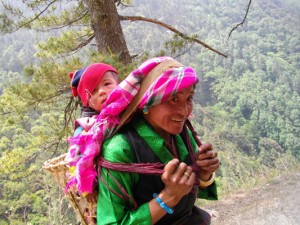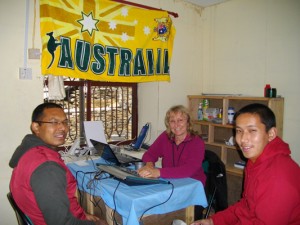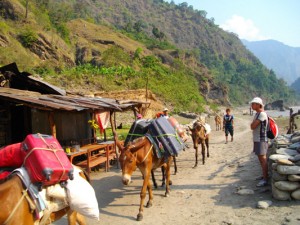Tsum Valley
 Are we there yet?… But before that, how are we getting there?
Are we there yet?… But before that, how are we getting there?
And we need to get there with our equipment dry, intact physically and complete in terms of that with which we left!
When we arrive, we need to organize a power supply that is functioning, that can be “tailored” such that spikes, over and under voltages, load shedding and unexpected failure are re-organized into a steady state pure sine wave 220 volt ac supply. Otherwise we will let smoke out of the testing and programming boxes!
Usually we begin by piling it on top of a jeep. For this story, we go to remote Tsum valley, behind Ganesh Himal Range, 3 to 4000m valley floor. We have trekked up (5 long days) and we have trekked back, but we like the helicopter at least one way, so up is best!
Kathmandu domestic airport, Keshab is always there when we arrive.
And then we go inside and stand guard again. It is interesting watching the locals plead with the “authorities” to let them take their jungle knives through, if they are so unlucky that they get “discovered”
 We then climb into the ute that delivers us to the helicopter.
We then climb into the ute that delivers us to the helicopter.
I must stress here that the helicopter is paid for by Sue and lew privately, with no costs borne by HearingNEPAL Program. Usually we catch a fuel run or backload, so it’s not too frightening.
 We weave up the valleys, shoot over a few ridges and look way up to the Himalayan Mountains cupping us, and then we land, and scurry, and it is quiet again. We have two “sometimes” supplies of hydropower. If the 12V batteries are fully charged when we arrive, we get by. We bring our own UPS (uninterrupted power supply – stabilised to 220V 50 Hz ac) for direct consumption from the mains and use a pure sine wave inverter off the batteries when no mains power. As most of our equipment is sourced in Australia we use Aus. Power boards, surge protectors, plugs and cords Two laptops, Itera diagnostic audiometer, 2 digital otoscopes, a diagnostic Otoflex tymp and reflex, programming equipment for Bernafon, Sonic and Siemens aids in this case, colour printer, maxi and mini alds and aids to fit moderate to profound losses, and the odd bone conductor. “Diagnostic” Sue in one room and lew fitting in a corner in the hall.
We weave up the valleys, shoot over a few ridges and look way up to the Himalayan Mountains cupping us, and then we land, and scurry, and it is quiet again. We have two “sometimes” supplies of hydropower. If the 12V batteries are fully charged when we arrive, we get by. We bring our own UPS (uninterrupted power supply – stabilised to 220V 50 Hz ac) for direct consumption from the mains and use a pure sine wave inverter off the batteries when no mains power. As most of our equipment is sourced in Australia we use Aus. Power boards, surge protectors, plugs and cords Two laptops, Itera diagnostic audiometer, 2 digital otoscopes, a diagnostic Otoflex tymp and reflex, programming equipment for Bernafon, Sonic and Siemens aids in this case, colour printer, maxi and mini alds and aids to fit moderate to profound losses, and the odd bone conductor. “Diagnostic” Sue in one room and lew fitting in a corner in the hall.

Keshab screens their hearing with a tuning fork, and notes whether they have a conductive or sensorineural loss.
Before we see any referrals, Keshab (Nepali trained “Ear Assistant” from NAHOH – Nepal) checks their ears, with a video otoscope – the educational value of which is “huge” and cleans their ears with a “Vorotek” head mounted otoscope and ENT instruments. If necessary, he prescribes and dispenses appropriate drugs (which we bring) and arranges (if possible) for any medical follow up in Kathmandu. He can arrange for them to attend “free” surgical camps or streamline their operation through the local teaching Hospital. He then refers them to Sangye (or Sarita or Bijay) for air conduction screening on our back up portable audiometer. All children with any hearing loss and adults with a 3FAHL > 50 dBHL are referred to Sue.

 Anyone for pasta… here on the Tibetan border. It is a toss up between the novelty of pasta and the most excellent valley potatoes, buttery yellow, oozing the richness of the fertile valley…organic as you can get!
Anyone for pasta… here on the Tibetan border. It is a toss up between the novelty of pasta and the most excellent valley potatoes, buttery yellow, oozing the richness of the fertile valley…organic as you can get!
In our food and weather alike…
Last June (2012) was our third visit, and so we leave 57 locals with hearing aids or Alternate listening devices. (Total for Nepal and Southern India now 327 items) Through Keshab from NAHOH over 400 locals were assisted through his primary ear care clinic. (Over 3000 in total now in Nepal) We rejoice with them and prepare to walk back…5 days.
 70 plus kg is this porter’s load. I offered to get extra porters, but they get paid by the kg, and are happy with up to 90kg.
70 plus kg is this porter’s load. I offered to get extra porters, but they get paid by the kg, and are happy with up to 90kg.
We take two porters, for 150kg total.
We travel with “day packs”, water, rain gear and energy food.
Early morning start, farewells and blessings and we are away into the morning freshness.
Khenrab, lew, Keshab, Sangye and Sue are honoured with traditional khatas for a safe journey, by Geshe Thubten Yonten (centre right) from Rachen Nunnery, where we held our camp.

 And we walk and rest, climb and slide till dusk.
And we walk and rest, climb and slide till dusk.
Next morning we set off for Sirdibas, arriving at lunch time. We then began organising power and a site for our camp, the next day.
Photo left: The notice on the pole in Sirdibas, announcing our hearing camp. Camps are held in association with the local authorities and health workers
 Photo left: Sue trains Sangye as the hearing tests proceed.
Photo left: Sue trains Sangye as the hearing tests proceed.
 Photo right: Locals gather and wait their turn, after enrolling.
Photo right: Locals gather and wait their turn, after enrolling.
We decided to hold the camp in Sirdibas, on the way back from Tsum, as many had made the journey to Tsum valley the previous year. Many were elderly, and it seemed like a good idea to save them the mountain trek.
 And so the donkeys are the revised transport for our equipment until we get to the road head.
And so the donkeys are the revised transport for our equipment until we get to the road head.
They stay on the main drag, while we are conned into a short cut!
 And cross the river – yet again
And cross the river – yet again
 The roads are varied, and incident packed, as the next Photo suggests. It was taken in the same region on a previous Tawal trip. Rod and Kylie from NAFA, Sangye (sitting) and the teddy bears all exhibit different degrees of interest.
The roads are varied, and incident packed, as the next Photo suggests. It was taken in the same region on a previous Tawal trip. Rod and Kylie from NAFA, Sangye (sitting) and the teddy bears all exhibit different degrees of interest.
So that’s what makes it happen… but going nowhere without your support.
Thanks for caring.








